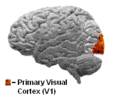Visual cortex facts for kids
The visual cortex is a special part of your brain that helps you see the world around you! It's pretty thin, only about 1.5 to 2 millimeters thick in humans. In animals like monkeys and apes, this part of the brain is much bigger. You can find your visual cortex at the very back of your brain, in an area called the occipital lobe.
Two scientists, David Hubel and Torsten Wiesel, spent many years studying the visual cortex. They even won the Nobel Prize in Physiology or Medicine in 1981 for their amazing discoveries about how our visual system works. Their research in the 1960s and 1970s helped us understand how our vision develops. They looked at how different parts of the visual cortex get signals from either your right or left eye. They also explained how your brain processes these signals to help you see things like edges, movement, depth (how far away things are), and colors. These are like the building blocks that help your brain understand everything you see!
Scientists learn about the visual cortex in different ways. Sometimes, they record tiny electrical signals (called action potentials) from inside the brains of animals like cats, ferrets, rats, mice, or monkeys. Other times, they use special tools like EEG, MEG, or fMRI to record signals from outside the brain. These methods are great because they don't involve going inside the brain at all!
Contents
What is the Primary Visual Cortex?
The primary visual cortex, often called V1, is the most studied part of the visual system in the brain. This is where the first messages about what you see arrive. These messages come from relay stations called the lateral geniculate nuclei. Each of these stations gets signals from the opposite side of what you're looking at. So, if you're looking to your right, the signals go to the left side of your brain!
Once the V1 receives this information, it sends it along two main paths, like two different roads for visual information. These are called the ventral stream and the dorsal stream.
The Ventral Stream: What Are You Seeing?
The ventral stream starts in V1, then goes through another visual area called V2, then V4, and finally to the inferior temporal cortex. This pathway is sometimes called the "What Pathway." It's super important for recognizing shapes and identifying objects. For example, it helps you know if you're looking at a ball, a dog, or a book. It also helps store these visual memories for a long time.
The Dorsal Stream: Where Is It and How Do You Interact?
The dorsal stream also starts in V1, then goes through V2, and then to areas like the dorsomedial area (DM/V6) and Visual area MT (middle temporal/V5), before heading to the posterior parietal cortex. This pathway is sometimes called the "Where Pathway" or "How Pathway." It helps you understand movement, where objects are located in space, and how to control your eyes and arms. For instance, it helps you guide your hand to pick up a toy or follow a moving object with your eyes.
Images for kids
See also
 In Spanish: Corteza visual para niños
In Spanish: Corteza visual para niños


